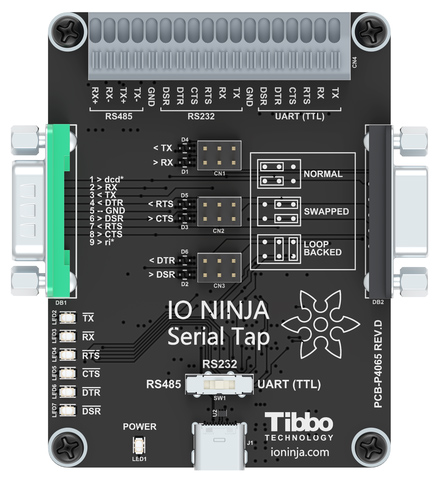
Serial Tap is an affordable serial sniffer that can monitor RS232, RS485, and TTL-level UART communications. The Tap connects to your PC via a USB cable and is compatible with IO Ninja terminal/sniffer software.
Features
•The Serial Tap is designed for use with IO Ninja software (http://ioninja.com/).
•Monitors TX, RX, RTS, CTS, DTR, and DSR lines [Note 1] of serial ports.
•All inputs are connected to an 18-position, quick-release terminal block.
•Has three operating modes: RS232, RS485 [Note 2], and UART (TTL [Note 3]), selectable via a slide switch:
oRS232 mode:
▪Two onboard DB9 connectors — male and female — offer true "cable wedge" sniffing [Note 4];
▪Six jumpers for swapping and loopbacking signals within RX/TX, RTS/CTS, and DTR/DSR pairs [Note 5];
▪Six bi-color LEDs indicate the status of monitored lines and allow distinguishing between the positive voltage (red), negative voltage (green), and zero voltage (off) states [Note 5];
▪DB9 connectors additionally pass through DCD and RI signals (without monitoring them).
oRS485 mode allows to monitor TX and RX signal pairs.
oUART (TTL) mode allows to monitor UARTs of IC chips with logic levels from 3.3V to 5V.
•Full-speed (12Mbps) USB2.0 interface on a USB-C connector.
•Six yellow LEDs indicate the state of six monitored lines as they enter the USB controller. LEDs turn on when the lines go LOW [Note 6].
•USB-powered, no additional external power necessary.
•Supplied with a USB-C cable and two DB9 gender changers.
•Compact, outside dimensions only 82 x 74 x 30 mm.
Note 1
A more accurate version of this statement would be: "Monitors two TX, two RTS, and two DTR lines," but that would be somewhat confusing to the reader. For clarity, we chose to list the lines as they are commonly known: TX, RX, RTS, CTS, DTR, and DSR. Keep in mind, however, that when it comes to sniffers, these names are relative and depend on the view. For two interconnected serial devices, a TX line on one end is an RX line on the other end. If so, which line is a "TX" and which line is an "RX" from the sniffer's point of view? Only you can answer this question. The Serial Tap itself has two inputs capable of monitoring serial data lines. Although they are both identical inputs, one is marked "TX" and another one is marked "RX." The same goes for other signals — RTS, CTS, DTR, and DSR. All these lines are inputs of the Tap. We gave them "regular" names to make the use of the Serial Tap intuitively easier. The same goes for RS485 lines. RX+/- and TX+/- pairs are both inputs of the Serial Tap.
This said, the Serial Tap incorporates two DB9 connectors, for which the distinction between TX and RX lines, RTS and CTS lines, and DTR and DSR lines is real. To give our terminology an anchored point of view, we have decided that the DB9-M connector on the left of the Tap is our "primary side" RS232 connector. For the entire board, all signal names are consistent with the standard pin assignment of this primary DB9-M connector. Of course, all "anchoring" disappears as soon as you abandon DB9s and plug into the terminal block lines.
Note 2
These inputs can also be used for monitoring RS422 communications.
Note 3
"TTL" here means "digital signals of microcontrollers, microprocessors, and other ICs." TTL inputs of the Serial Tap are also compatible with CMOS circuitry. Most importantly, "TTL" serial signals are usually inverted with respect to RS232 signals: a LOW (negative voltage) on an RS232 line corresponds to a HIGH level on a serial TTL (CMOS) line, and HIGH (positive voltage) on an RS232 line corresponds to a LOW level on a serial TTL (CMOS) line.
Note 4
TX, RX, RTS, CTS, DTR, and DSR lines of the primary DB9 connector located on the left of the Serial Tap are connected in parallel with RS232 inputs on the terminal block. This can be seen on the Block Diagram of the Serial Tap.
Note 5
Jumpers and bi-color LEDs on RS232 lines give the Serial Tap the second use as a simple mating and signal checking tool for serial devices.
Note 6
This statement pertains to the latest revision D of the product. On the earlier (and now obsolete) revision C, yellow LEDs used to turn on when the lines went HIGH.